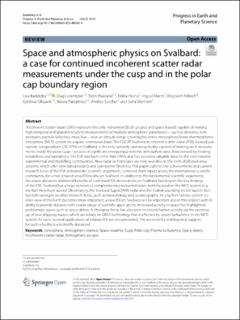| dc.contributor.author | Baddeley, Lisa | |
| dc.contributor.author | Lorentzen, Dag Arne | |
| dc.contributor.author | Haaland, Stein Egil | |
| dc.contributor.author | Heino, Erkka Petteri | |
| dc.contributor.author | Mann, Ingrid Brigitte | |
| dc.contributor.author | Miloch, Wojciech Jacek | |
| dc.contributor.author | Oksavik, Kjellmar | |
| dc.contributor.author | Partamies, Noora | |
| dc.contributor.author | Spicher, Andres | |
| dc.contributor.author | Vierinen, Juha-Pekka | |
| dc.date.accessioned | 2023-10-11T09:49:14Z | |
| dc.date.available | 2023-10-11T09:49:14Z | |
| dc.date.created | 2023-09-27T13:04:25Z | |
| dc.date.issued | 2023 | |
| dc.identifier.issn | 2197-4284 | |
| dc.identifier.uri | https://hdl.handle.net/11250/3095750 | |
| dc.description.abstract | Incoherent scatter radars (ISRs) represent the only instrument (both ground and space based) capable of making high temporal and spatial resolution measurements of multiple atmospheric parameters—such as densities, temperatures, particle velocities, mass flux—over an altitude range covering the entire mesosphere/lower thermosphere/ionosphere (MLTI) system on a quasi-continuous basis. The EISCAT Svalbard incoherent scatter radar (ESR), located just outside Longyearbyen (78.15∘ N) on Svalbard, is the only currently operating facility capable of making such measurements inside the polar cusp—an area of significant energy input into the atmosphere and characterized by heating instabilities and turbulence. The ESR was built in the mid-1990s and has provided valuable data for the international experimental and modelling communities. New radar technologies are now available, in the form of phased array systems, which offer new data products and operational flexibility. This paper outlines the achievements and current research focus of the ESR and provides scientific arguments, compiled from inputs across the international scientific community, for a new phased array ISR facility on Svalbard. In addition to the fundamental scientific arguments, the paper discusses additional benefits of continued ISR observations on Svalbard, building on the key findings of the ESR. Svalbard has a large network of complementary instrumentation both focused on the MLTI system (e.g. the Kjell Henriksen auroral Observatory, the Svalbard SuperDARN radar and the Svalrak sounding rocket launch facility) with synergies to other research fields, such as meteorology and oceanography. As a further holistic system science view of the Earth becomes more important, a new ISR on Svalbard will be important also in this respect with its ability to provide datasets with a wide range of scientific applications. Increased activity in space has highlighted problematic issues such as space debris. A changing Arctic has also seen increased human activity via the opening up of new shipping routes, which are reliant on GNSS technology that is effected by severe turbulence in the MLTI system. As such, societal applications of a future ISR are also presented. The accessibility and logistical support for such a facility is also briefly discussed. | en_US |
| dc.language.iso | eng | en_US |
| dc.publisher | Springer Open | en_US |
| dc.rights | Navngivelse 4.0 Internasjonal | * |
| dc.rights.uri | http://creativecommons.org/licenses/by/4.0/deed.no | * |
| dc.title | Space and atmospheric physics on Svalbard: a case for continued incoherent scatter radar measurements under the cusp and in the polar cap boundary region | en_US |
| dc.type | Journal article | en_US |
| dc.type | Peer reviewed | en_US |
| dc.description.version | publishedVersion | en_US |
| dc.rights.holder | Copyright 2023 the authors | en_US |
| dc.source.articlenumber | 53 | en_US |
| cristin.ispublished | true | |
| cristin.fulltext | original | |
| cristin.qualitycode | 1 | |
| dc.identifier.doi | 10.1186/s40645-023-00585-9 | |
| dc.identifier.cristin | 2179409 | |
| dc.source.journal | Progress in Earth and Planetary Science | en_US |
| dc.relation.project | Norges forskningsråd: 329681 | en_US |
| dc.identifier.citation | Progress in Earth and Planetary Science. 2023, 10, 53. | en_US |
| dc.source.volume | 10 | en_US |

